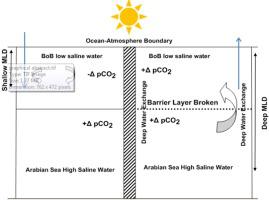Progress in Oceanography ( IF 3.8 ) Pub Date : 2021-07-03 , DOI: 10.1016/j.pocean.2021.102638 Rajdeep Roy 1 , P.N. Vinayachandran 2 , Amit Sarkar 3, 4 , Jenson George 2, 3 , Chandanlal Parida 2 , Aneesh Lotliker 5 , Satya Prakash 5 , Saroj Bondhu Choudhury 1

|
During the summer monsoon (June–September), the influence of cyclonic curl of local winds causes the formation of a thermocline dome called the Sri Lankan Dome (SLD) in the southern Bay of Bengal (BoB). In addition, the subsurface flow associated with the Summer Monsoon Current (SMC) brings Arabian Sea-High Salinity Water mass to the southern BoB. We show that both these oceanographic features are enriched in dissolved CO2 with the upper boundary shoaling very close to the surface. We observed episodic deep mixing events leading to entrainment of CO2-rich subsurface water with the mixed layer. CO2 disequilibrium within the top 45 m reached as high as + 404 µatm. Our estimated mixed layer ventilation rates ranged between 2.4 and 4.6 days between sampling stations suggesting equilibration with upwelled waters were still evolving. We also encountered a patch of Arabian Sea-High Salinity Water mass with low aqueous pCO2 suggesting past ventilation. Our modest estimates suggest a grid area of 2° latitude × 2° longitude can trigger a mean release of 0.78 Gg C day−1, which is significantly higher than the estimated new production rates due to upwelled nutrients. Our study illustrates that upwelled water associated with the SLD in conjunction with the barrier layer erosion accompanied with the flow of SMC has the potential to occasionally ventilate in southern BoB. We believe that these processes can negate the region's benefits by acting as a CO2 source which underscores the need for detailed investigation.
中文翻译:

孟加拉湾南部:夏季季风期间可能的二氧化碳排放热点
在夏季风期间(6 月至 9 月),当地风的旋风卷曲的影响导致在孟加拉湾南部 (BoB) 形成一个称为斯里兰卡穹顶 (SLD) 的温跃层穹顶。此外,与夏季季风流 (SMC) 相关的地下流动将阿拉伯海高盐度水团带到了 BoB 南部。我们表明,这两个海洋特征都富含溶解的 CO 2,上边界浅滩非常靠近地表。我们观察到偶发性深度混合事件导致富含 CO 2 的地下水被混合层夹带。CO 2顶部 45 m 内的不平衡高达 + 404 µatm。我们估计的采样站之间的混合层通风率介于 2.4 到 4.6 天之间,这表明与上升流水的平衡仍在发展。我们还遇到了一片阿拉伯海-高盐度水团,其 pCO 2水溶液含量低,表明过去的通风。我们适度的估计表明 2° 纬度 × 2° 经度的网格区域可以触发 0.78 Gg C day -1的平均释放,由于养分上升,这明显高于估计的新生产率。我们的研究表明,与 SLD 相关的上涌水以及伴随 SMC 流动的屏障层侵蚀有可能在 BoB 南部偶尔通风。我们认为,这些过程会充当 CO 2源,从而抵消该地区的利益,这强调了进行详细调查的必要性。











































 京公网安备 11010802027423号
京公网安备 11010802027423号